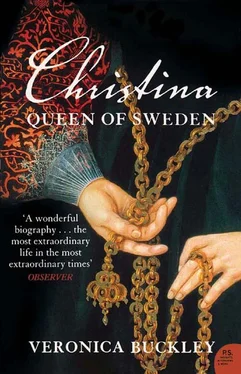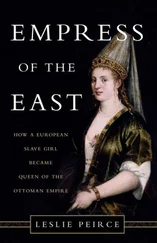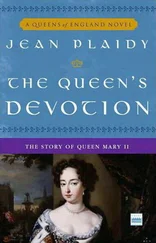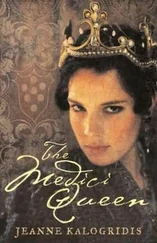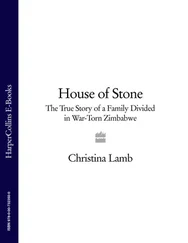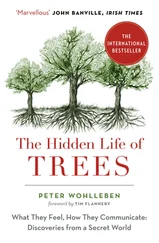There was not much else, it seems, in Maria Eleonora’s head. She had chafed at her school lessons, and she had no interest now in learning or literature. But she was lighthearted, prettier than most girls, and at least with a genuine love of music and art. No doubt these things were spoken of in the further meetings which were soon arranged between the two, for the King himself enjoyed them both; he was interested in painting, and he played the lute well. Johan Hand records that the couple met privately several times, that they dined together and conversed at length, and that Gustav Adolf did not depart unkissed. On the whole, he was pleased to have made the journey. The girl’s grandfather and great-uncle had been insane, it was true, but this could hardly count against her, for had not his own uncle and aunt been the same? 2
For her part, Maria Eleonora was delighted. She soon discovered the true identity of the handsome ‘Adolf Karlsson’, and, turning her heart where duty lay, promptly fell in love with him. In this, at least, she showed good judgement, for the young King was among the very finest men of his age, able and cultivated, brave, strong, and generous, courteous, farsighted, conscientious, and just, an inspired military leader and a man of profound religious humility, amply deserving the epithet that his dazzled contemporaries would one day accord him – Gustav Adolf the Great. Had he lived in a time of peace, his many gifts might have borne yet finer fruits, but in 1611, when he had come to the throne at the age of only sixteen, his tiny country was already at war with Denmark, and by 1618, at the outbreak of the Thirty Years War, Sweden had embarked on warfare to last a generation, in which the greathearted King, the ‘lion of the north’, was to lose his own life.
But for now, Gustav Adolf’s fine soldier’s reputation can only have added to his attraction. For Maria Eleonora, he seemed the fulfilment of a dream, indeed, the fulfilment of a prophecy, for her father’s own astrologer had once predicted that she would grow up to marry a king. The King himself was not so sure. Though he wanted to marry quickly, a Brandenburg connection was not the only possibility. In the ripening spring, he made his way southward, pausing in the vibrant town of Frankfurt am Main, where books and silks and jewellery were traded in the busy streets beneath the great cathedral. While there, he took the time to purchase a magnificent diamond necklace at a value of almost 9,000 riksdaler – the price of 3,000 cows, no less – borrowing the money from his brother-in-law to do so. As yet, however, he had not decided whose neck the lovely item would adorn.
From Frankfurt, he made his way to Heidelberg, there to cast his eye upon an alternative marriage candidate, the Princess Katharina, sister of Friedrich V, Elector and Prince Palatine of the Rhine, the unhappy ‘Winter King’ of Bohemia. The Swedish King had maintained his incognito, but he was now dressed as an army captain, and disguised by the simple acronym of Gars – Gustavus Adolphus Rex Sueciae – Gustav Adolf, King of Sweden. The Princess, a young lady of generous circumference but, it seems, no great perspicacity, failed to recognize her prospective suitor. She mistook his interested approach for impertinence, declaring to her sister, in imperious French, ‘What intrusive people these Swedes are!’ Alas, among the eleven languages understood by the clever King, French was not the least. 3The portly princess had cooked her goose. Gustav Adolf decided that the pretty little Countess of Brandenburg would suit him better, and in due course he made his way back to Stockholm, dispatching his friend and Chancellor, Axel Oxenstierna, to complete the arrangements in Berlin, while the Countess herself sat down to pen an excited letter to her grudgingly accepting brother. ‘The whole journey was like a play,’ wrote Johan Hand in his diary. 4
But if the journey was a romantic comedy, it was not without its dramatic aspects. His search for a wife in the German lands had allowed Gustav Adolf to assess the strengths and weaknesses of the various princes who served as a Protestant bulwark against the Catholic Habsburgs. He was not impressed, and he returned contemptuous of their ‘feebleness, cross-purposes, selfishness, and military incompetence’, an ill omen for the Protestant alliance that he would later attempt to forge. 5
In the autumn Maria Eleonora and Chancellor Oxenstierna set out upon the northward road, accompanied by the Electress Dowager and her youngest daughter, Katharina, together with the bride’s personal secretary and many ladies-in-waiting. They travelled in some comfort, their journey assisted – and the bride’s dowry increased – by the pawning of valuables which the Electress Dowager had raided from the Brandenburg state treasury. At Kalmar, not far from the Danish border, they stopped, for here the King himself had come to meet them, pausing en route to purify the land for his bride by torching a number of plague-stricken houses in the surrounding countryside.
At Kalmar, the party passed several days of alternate rest and celebration in the beautiful castle beside its placid harbour. It was an historic place, for here, more than two hundred years before, the triple-Queen Margareta had united Sweden with the neighbouring lands of Norway and a dominant Denmark, a union against which Gustav Adolf’s own grandfather had led his people to rebel. 6Kalmar was Sweden’s architectural jewel, a castle of fairytale beauty and among the finest in Europe, built with a sure artistic sense by the King’s Renaissance forebears. Many of its rooms were beautifully decorated, with painted mouldings and inlaid wood, and finely made furniture from the lands to the south. No doubt it was all displayed with pride to the newcomers, and perhaps, too, the young bride was teased with horror stories of the murders which the same rooms had witnessed, not so very long before. 7If so, they did not deter her. The bridegroom set out for the Tre Kronor Castle, thoughtfully going ahead to give his personal attention to the heating of Maria Eleonora’s rooms, and soon she set out after him with her own entourage on the long, hard journey to Stockholm, 300 miles northward, with the winter closing in around them.
If the sophisticated ambience of Kalmar had reassured the young bride, her composure was soon to be tested as she made her way through her new-found country, for as yet Sweden had little to impress a German countess. Its climate harsh and its people few, it was overwhelmingly rural, with small clusters of farmsteads thinly spread over the less inhospitable southern areas. Lakes and forests dwarfed and isolated all but the largest settlements. Befitting their rural homeland, almost all the Swedes, about a million souls in all, were peasants. A few tens of thousands lived in small and undeveloped towns, and even the nobles mostly chose to live in the countryside, putting their modest incomes back into the land. The very crown revenues, including taxes, were still paid in kind; grain and fish and butter, hides and furs, and iron and copper from Dutch-owned mines, all poured into the royal warehouses, and out of them, too, for the crown’s own servants and even foreign creditors were paid in kind as well. In the early days of Gustav Adolf’s reign, meetings of parliament had taken place in the open air, while at the Tre Kronor Castle, the monarch’s own residence, the doors remained open to all comers.
As the weary train arrived in Stockholm, the young bride’s deepening disappointment turned to dismay. Not yet the country’s formal capital, the grand northern city where she had thought to make her home was in fact scarcely more than a backward country town, its muddy streets lined with basic wooden houses, unwarmed as yet by the ubiquitous red paint that would one day turn their roughness to charm. Goats wandered on the brown turf rooves, nibbling at the roots and grass, sending a plaintive bleating into the chilly air. Inside, the dwellings of rich and poor alike were largely bare, with little covering on the floors and less upon the walls, and now, in the gathering winter, reliably cold. Though the King himself, like his forefathers, was genuinely interested in architecture and the fine arts, there had been little excess wealth for great public buildings or lavish artistic patronage; native literature and music remained rudimentary, theatre almost unknown, paintings and sculpture rare, and Sweden’s nobles, in their bare-walled, bare-floored houses, largely unconvinced. To the citizens of the superbly cultured towns of Italy, or to those of Holland with its advanced financial system and its plethora of cheap goods, Sweden seemed a desperate outpost at the ends of the earth. To Maria Eleonora, accustomed to the rich heritage of Brandenburg and with cultural pretensions of her own, disdain was now added to disappointment. She conceived a contempt for the land and its people, her husband only excepted, and garnered much ill will from her offended new compatriots.
Читать дальше
